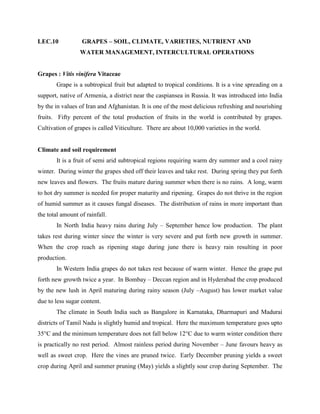
GRAPES
- 1. LEC.10 GRAPES – SOIL, CLIMATE, VARIETIES, NUTRIENT AND WATER MANAGEMENT, INTERCULTURAL OPERATIONS Grapes : Vitis vinifera Vitaceae Grape is a subtropical fruit but adapted to tropical conditions. It is a vine spreading on a support, native of Armenia, a district near the caspiansea in Russia. It was introduced into India by the in values of Iran and Afghanistan. It is one of the most delicious refreshing and nourishing fruits. Fifty percent of the total production of fruits in the world is contributed by grapes. Cultivation of grapes is called Viticulture. There are about 10,000 varieties in the world. Climate and soil requirement It is a fruit of semi arid subtropical regions requiring warm dry summer and a cool rainy winter. During winter the grapes shed off their leaves and take rest. During spring they put forth new leaves and flowers. The fruits mature during summer when there is no rains. A long, warm to hot dry summer is needed for proper maturity and ripening. Grapes do not thrive in the region of humid summer as it causes fungal diseases. The distribution of rains in more important than the total amount of rainfall. In North India heavy rains during July – September hence low production. The plant takes rest during winter since the winter is very severe and put forth new growth in summer. When the crop reach as ripening stage during june there is heavy rain resulting in poor production. In Western India grapes do not takes rest because of warm winter. Hence the grape put forth new growth twice a year. In Bombay – Deccan region and in Hyderabad the crop produced by the new lush in April maturing during rainy season (July –August) has lower market value due to less sugar content. The climate in South India such as Bangalore in Karnataka, Dharmapuri and Madurai districts of Tamil Nadu is slightly humid and tropical. Here the maximum temperature goes upto 35°C and the minimum temperature does not fall below 12°C due to warm winter condition there is practically no rest period. Almost rainless period during November – June favours heavy as well as sweet crop. Here the vines are pruned twice. Early December pruning yields a sweet crop during April and summer pruning (May) yields a slightly sour crop during September. The
- 2. climatic conditions are favourable is parts of Tamil Nadu so that 5 crops are taken in 2 years by staggered pruning techniques. Soil Well – drained rich loamy soil with pH of 6.5-7.0. Soil depth should be almost 1 m. Propagation Propagated by hard wood cuttings prepared from matured canes (one year old shoot) of healthy, moderately vigorous, virus tree vines. Cuttings of 25-30 cm length are prepared by making the lower cut just below a bud and upper cut slightly above the bud. Cuttings should be tied and stored in moist sand for a month for callusing. The callused cuttings start well in the nursery. While planting only one bud in left above the ground level and remaining portion buried in soil. At the end of winter the sprouted and rooted cuttings can be lifted and planted in the main yield. Grafting and budding is practiced with a particular root stock for specific requirement. a. Phylloxera resistant root stock Vitis riparia, V. rupestris b. Nematode resistant root stock Dogridge, Salt creek c. Saline tolerant : Solanis, 1616 Preparation of main field and planting Trenched of 0.6 m width and 0.6 m depth are dug at a distance of 3 m apart for Muscat. Other varieties 1 m3 pits are drug. Well decomposed FYM or compost or green leaf manure has to be applied in the trenches or pit and then covered with soil. The rooted cuttings are planted during June – July. Spacing: 3 x 2 m for Muscat 4 x 3 m for other Varieties Irrigation Immediately after planting 3rd day and once in a week. Irrigation with held 15 days before pruning and also 15 days before harvest. Manuring and fertilizer (kg pervine)
- 3. Variety FYM Green leaves N P K I II III I II III I II III I II III I II III Muscat 50 50 100 50 50 100 0.10 0.20 0.20 0.08 0.16 0.16 0.30 0.4 0.60 Thom -pron seedless 50 50 100 50 50 100 0.20 0.30 0.40 0.08 0.16 0.24 0.40 0.80 0.120 The manures should be applied twice after pruning. Apply half the dose of K immediately after pruning and the other half after 60 days of pruning. Foliary spray of 0.1% boric acid + 0.2 % ZnSO4 + 1.0% urea twice before flowering and 10 days after first spray to overcome nutrient deficiency. Special practices Tipping of shoots and tying of clusters in the pandal after the fruit set. Remove tendrils. Nipping the growing shoots of axillary buds and terminal buds at 12 to 15 buds. Thinning the compact bunches by removing 20% of the berries at pea stage. The clusters are dipped in a solution containing Brassinosteriod 0.5 ppm and GA3 25 ppm at 10-12 days after fruit set to maintain vigour, yield and quality parameters.